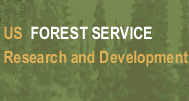

|
AWAE Program Headquarters Boise, ID 83702 (208) 373-4340
(970) 295-5923 |
|
|
|
|
|
Rocky Mountain Research Station Home > Science Program Areas > Air, Water and Aquatics > Boise Lab Stream Temperature Modeling
modeling Introduction Thermal regimes are important to aquatic ecosystems because they strongly dictate species distributions, productivity, and abundance. Inexpensive digital temperature loggers, geographic information systems (GIS), and remote sensing technologies are now facilitating the development of temperature models applicable at broad spatial scales. This web site describes three different statistical procedures for predicting suitable fish habitat by modeling or inferring stream temperature. Statistical temperature models are well suited for broad-scale applications because they are less data intensive than mechanistic stream models, provide estimates of parameter precision, and can often be easily derived from existing databases. The web site also provides links to other stream temperature resources such as publications, videos, and data. This information has been produced or compiled by the U.S. Forest Service, Rocky Mountain Research Station, Boise Aquatic Sciences Lab.
temperature Models |
|
|||||||||
|
Air Temperature Based Thermal Stream Habitat Model This model was developed for predictions across the interior Columbia River basin in the Pacific Northwest. The model predicts the distribution of thermally suitable habitat for bull trout by incorporating air temperature, elevation, latitude, and longitude. |
||||||||||
|
|
||||||||||
|
Spatial Statistical Stream Temperature Model This stream temperature modeling approach uses thermograph data and the predictor variables: air temperature, solar radiation, elevation, and stream flow. GIS and spatial statistical models that account for network topology were used to predict stream temperatures at 1 km intervals throughout a 2,500 km river network. |
||||||||||
|
|
||||||||||
|
|
Multiple Regression Stream Temperature Model This modeling approach uses thermograph records and a simple set of geomorphic predictor variables derived from digital elevation models (DEM). A multiple regression model and GIS are used to predict stream temperatures for individual reaches throughout a river network. |
|||||||||
|
other Resources
|
||||||||||
| additional Publications
|
||||||||||
|
Dunham, J., B. Rieman and G. Chandler 2003. Influences of temperature and environmental variables on the distribution of bull trout within streams at the southern margin of its range. North American Journal of Fisheries Management 23:894-904. |
||||||||||
| Dunham, J., R. Schroeter and B. Rieman 2003. Influence of maximum water temperature on occurrence of Lahontan cutthroat trout within streams. North American Journal of Fisheries Management 23:1042-1049. | ||||||||||
| Meeuwig, M. H.; Dunham, J. B.; Hayes, J. P.; Vinyard, G. L. 2004. Effects of constant and cyclical thermal regimes on growth and feeding of juvenile cutthroat trout of variable sizes. Ecology of Freshwater Fish. 13(3): 208–216. | ||||||||||
| Isaak, D.J., and W.A. Hubert. 2004. Nonlinear response of trout abundance to summer stream temperatures across a thermally diverse montane landscape. Transactions of the American Fisheries Society 133:1254-1259. | ||||||||||
| Isaak, D.J., and W.A. Hubert. 2001. A hypothesis about factors that affect maximum summer stream temperatures across montane landscapes. Journal of the American Water Resources Association 37:351-366. | ||||||||||
Rocky Mountain Research Station
- Air, Water and Aquatic Environments Sciences Program
Last Modified:
Wednesday, 01 April 2009 at 18:27:55 EDT








